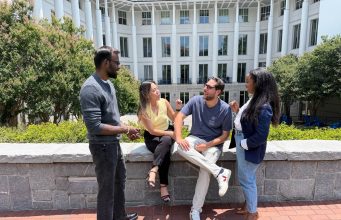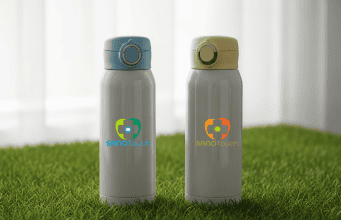When companies tap Ruomeng Cui to tackle a complex business problem, they not only get her expertise in creating algorithms and optimization—they gain access to industry expertise and an innovative problem-solver.
Cui is a Goizueta Foundation Term Associate Professor of Information Systems & Operations Management at Emory’s Goizueta Business School. She helps tech firms and others, like Tencent, Alibaba, PepsiCo, JD.com and Collage.com, leverage big data and algorithms to innovate their decision-making processes, benefiting customers, sellers, and the companies.
Students reap the advantages of her deep industry exposure, too. Cui regularly weaves the challenges and techniques, everything from navigating AI to effective communications, into lectures and assignments, providing students with nuanced, real-world applications.
From Academia to Amazon
Cui’s most recent foray into industry is working as an Amazon Scholar. The program is designed for academics from universities around the globe who want to work on large-scale technical challenges while continuing to teach and conduct research. For Cui, it’s meant taking a sabbatical and working at Amazon full-time for more than two years, diving into the organization’s various departments and collaborating “with their other scientists, their product managers, and engineers to develop products to implement at the scale of Amazon.”
In this capacity, Cui’s worked across teams including robotics and Amazon FBA, which provides fulfillment services for ecommerce businesses. She spends the most time with the supply chain and optimization technology group.
You can think of it as Amazon’s brain: every order that you receive has layers of this group’s algorithms.
Ruomeng Cui, Goizueta Foundation Term Associate Professor of Information Systems & Operations Management
No matter what area of the business she is focusing on, “my role has always been scientist,” she says. “First, I design data-driven algorithms. Data-driven plus optimization, that’s my expertise. Then I put those algorithms in production to make smart and scalable supply chain decisions, or seller-related decisions, or packaging-related decisions.”
Solving Complex Challenges with Data
As a scholar, she never knows what type of challenge the world’s largest retailor may send her way. One approach she often applies when tackling issues is the “backward induction” principal, where she starts with understanding the business problem by talking with stakeholders.
“I talk a lot with the product managers or engineers, or whoever owns the certain decision-making systems to understand their pain points,” she says.
The goal, she explains, is to identify where the current algorithmic programming or decision-making process of the algorithm breaks down or is not producing the ideal results. “For example, the decisions are not automated enough, the decisions are not smart enough, or the decisions were based on some simple heuristic rules that they feel might have some inefficiencies,” she says. “So, I just talk with them to understand the nature of the business problem.”
Designing Algorithms that Deliver
The next step in designing the best scientific solution involves the “invent and simplify” principal, where she breaks the problem down into smaller parts and conquers it.
Once she’s zeroed in on the business needs, “that’s where my value kicks in,” says Cui.
When I hear a certain business problem, I can tell, “oh, this is a prediction-based problem” or I realize, “this is a causal-based problem, and they’re currently using some prediction or very simple heuristic rules that has nothing to do with causal.”
Ruomeng Cui
“Then I know, from a science sense, that there should be improvements if we use the right tools to tackle the problem.”
Cui will then determine whether a redesign or new algorithm is needed, then share her proposed solutions with key stakeholders.
Her next steps include collecting data from a company’s existing system to see how the data works, then beginning to develop a new algorithm. She will then “train the model and test the counterfactual performance” of the system if the new algorithm is implemented.
“Basically, we run a simulation to show how the algorithm would run if it had been designed based on my decisions. Then I would share how my outcomes differ, like different profits, different sales, and how these outcomes would beat the [existing] history by 5% or by 1%, saving the company extra money—for example, $10 million per year.”
Communicating Complex Science
Cui believes that it is an important practical skill to address stakeholder questions and convey the statistics and results in a way her audience can understand, be it software engineer, marketer, or senior executive, noting effective communications is just as vital as the science.
When I’m going to present the results to leadership, they need to understand the logic of how the new algorithm works and why this algorithm makes sense.
Ruomeng Cui
Further, she stresses, “You have to stand in their shoes, to speak their language, then persuade them that whatever you’re proposing is going to work out really well. Your idea, this solution, will require allocation of resources—human capital, time, and money. So, you need to be clear on the benefit you can bring to influence others to make changes.”
Sharpening Her Skills
For Amazon and various companies that she collaborates with, Cui builds and develops cutting-edge identify-then-optimize, causal machine learning, optimization and economic techniques to make smart supply chain, operations, and marketing decisions.
As an industry consultant, her solutions save companies a significant amount of time and money. Due to the intricacy of her algorithmic redesigns, she continues to collaborate in research with various companies.
Cui notes that working in industry keeps her skillsets sharp in a different way than with research.
In an academic paper, you can always assume the difficulties away. But when working in industry, you have to deal with the difficulties, the real-world issues, then reach a conclusion and find a solution quickly.
Ruomeng Cui
“You always have to find a balance between efficiency and a solution that has good usefulness and is quick solving,” she notes.
Bridging Theory and Practice
At Goizueta, faculty like Cui regularly advise companies and offer their expertise, bridging the gap between theory and practice.
Indeed, to stay abreast of the ever-evolving landscape, Cui stays current by attending industry conferences and proactively networking.
“I put a lot of effort into building connections, attending conferences when I can in order to meet industry people and make connections. For example, I met the general manager of data science of Tencent two or three years ago at Knowledge Discovery and Data Mining, or KDD, which is the largest, top-notch data science conference.”
Cultivating that relationship resulted in the gaming giant providing research collaborations for a few doctoral students that she coaches.
Cui uses her industry cache to assist other students in finding opportunities, as well. Her influence helped two graduates of Goizueta’s PhD program secure faculty positions, one at Auburn University and the other at NYU Shanghai. Recently, she was able to coach a few of her students from the undergraduate Bachelor of Business Administration (BBA) program, MBA program, and MS in Business Analytics program from last year—all were seeking advice on ways they could work at technology or supply chain firms.
Back to the Classroom
As much as Cui enjoys the pressure and challenges of working for industry, she is always eager to bring her insights back to the classroom.
“When I go back to school and teach MBA or undergraduate business students about business courses, I tell them about my experiences. For instance, when I teach process flows, I share a problem, difficulty or mistake from a previous project. For example, we need to involve engineers as early as possible in the product design process, otherwise, it would cause delays in the process of resource allocation,” she says.
The lesson: when designing a process, you want to involve the engineers as early as possible. Also, her work with PepsiCo is often referenced to illustrate how to design a batch process.
All of these experiences, this real-life experience, gets to become my teaching material as well.
Ruomeng Cui
Given her industry experience, Cui says, even an Introduction to Operations course is enriched by her exposure to various companies.
“Now, in the introduction session, when giving an example of Amazon’s operational excellence, I have a deeper understanding of how Amazon excels, and how Amazon cleverly leverages data and relies on science to make all kinds of rigorous, scientific and efficient decisions.”
Finally, Cui says her experience with Amazon and other companies inspire a lot of her research. She has a number of papers in the pipeline focusing on causal machine learning method development, identify-then-optimize online platforms, delivery time, and regulation. Her most recent published works feature topics like last-mile delivery, remote learning and disclosing product availability in online retail and exploration of apps and operating systems in mobile commerce.
Goizueta faculty bring real-world insight into every classroom. Discover how their research and industry experience shape the leaders of tomorrow. Meet our faculty.











